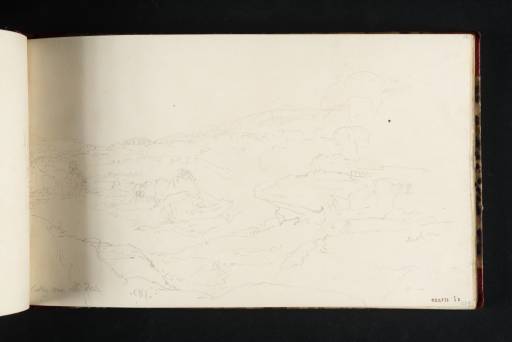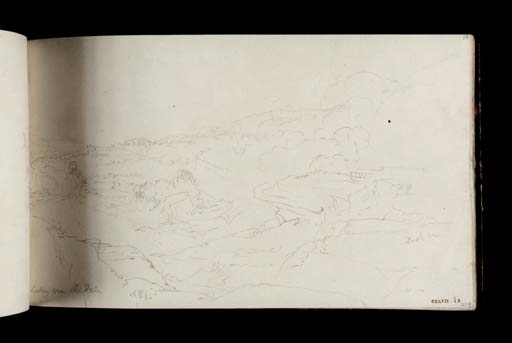Joseph Mallord William Turner Aysgarth Force, Looking down the Fall 1816
Image 1 of 2
Joseph Mallord William Turner,
Aysgarth Force, Looking down the Fall
1816
Joseph Mallord William Turner 1775–1851
Folio 12 Recto:
Aysgarth Force, Looking down the Fall 1816
D11460
Turner Bequest CXLVII 12
Turner Bequest CXLVII 12
Pencil on white wove paper, 125 x 206 mm
Watermarked ‘J WH[ATMAN] 18[14]’
Inscribed by Turner in pencil ‘Looking down the Fall’ bottom left and ‘Dark W’ right
Inscribed by ?John Ruskin in blue ink ‘279’ bottom right and ‘12’ top right
Stamped in black ‘CXLVII 12’ bottom right
Watermarked ‘J WH[ATMAN] 18[14]’
Inscribed by Turner in pencil ‘Looking down the Fall’ bottom left and ‘Dark W’ right
Inscribed by ?John Ruskin in blue ink ‘279’ bottom right and ‘12’ top right
Stamped in black ‘CXLVII 12’ bottom right
Accepted by the nation as part of the Turner Bequest 1856
References
1909
A.J. Finberg, A Complete Inventory of the Drawings of the Turner Bequest, London 1909, vol.I, p.424, CXLVII 12, as ‘“Looking Down the Fall.”’.
1980
David Hill, Stanley Warburton, Mary Tussey and others, Turner in Yorkshire, exhibition catalogue, York City Art Gallery 1980, p.79, no.121.
1982
Stanley Warburton, Turner and Dr. Whitaker, exhibition catalogue, Towneley Hall Art Gallery & Museums, Burnley 1982, no.55.
1984
David Hill, In Turner’s Footsteps: Through the Hills and Dales of Northern England, London 1984, pp.31, 58, 127.
1997
Martin F. Krause, Turner in Indianapolis: The Pantzer Collection of Drawings and Watercolors by J.M.W. Turner and his Contemporaries at the Indianapolis Museum of Art, Indianapolis 1997, p.125, no.35.
Aysgarth Force is the furthest downstream and the grandest of three falls on the River Ure at Aysgarth. In this sketch Turner is looking downstream from the left bank at the top of the falls. The higher ground to the right is the subject of an earlier drawing in this sketchbook, recording Wensleydale from above West Burton (folio 10 recto; D11457). The present subject is continued to the left on the facing page, folio 11 verso (D11459).
The building against the trees in the left distance is the Belvedere Temple. This two storey octagonal structure, with a shallow domed lead roof, survives, fairly well hidden by trees, by the side of the main road to West Witton opposite Temple Farm. It was built in 1792 by John Foss of Richmond for T.J. Anderson of nearby Swinithwaite Hall. It seems to have been intended as an estate ornament, principally to provide a platform from which to survey the surrounding prospect of Wensleydale. When built, admiration for such scenery would have constituted quite advanced taste. It is all the more remarkable that a gentleman should have gone to such lengths to encourage it. It must have given the scenery in this area a certain celebrity, and possibly accounts for Turner’s panoramic treatment of the area, for example in his foregoing sketch, D11457.
Turner sketched a similar view in the Yorkshire 2 sketchbook (Tate D11269; Turner Bequest CXLV 135), which accompanied him on the same tour.
David Hill
February 2009
How to cite
David Hill, ‘Aysgarth Force, Looking down the Fall 1816 by Joseph Mallord William Turner’, catalogue entry, February 2009, in David Blayney Brown (ed.), J.M.W. Turner: Sketchbooks, Drawings and Watercolours, Tate Research Publication, December 2013, https://www


